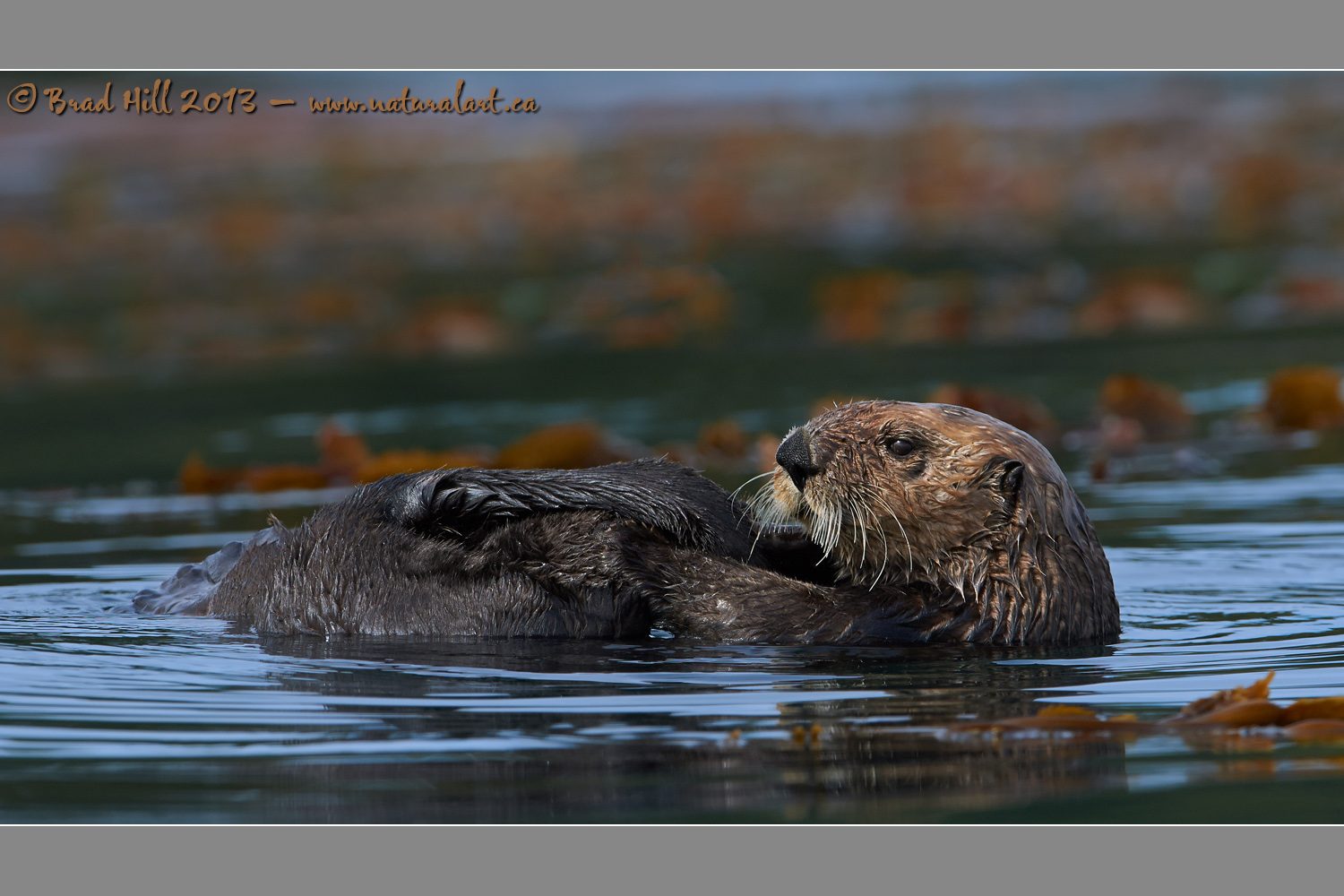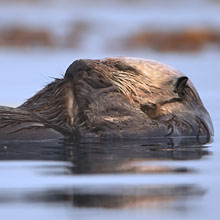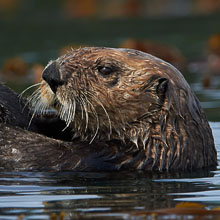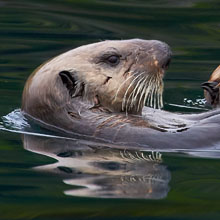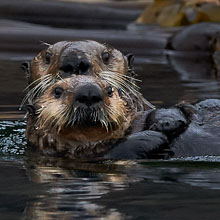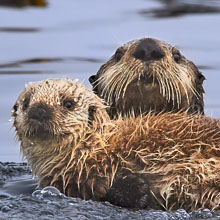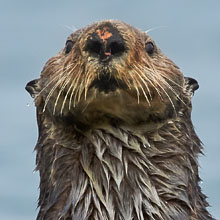Availability: Undetermined - Enquiries?
In the Field
A Time to Pause. Northern Vancouver Island, BC, Canada. August 20, 2013.
I captured this sea otter image in August of 2013 while leading my annual "Humpbacks, Orcas, Sea Lions and More" photo tour.
There are two elements of rarity associated with this image - a wild sea otter in British Columbia waters, and a waking sea otter doing close to nothing! Sea otters were extirpated from the entire coast of BC a little over a century ago. They were sought after for their luxuriant coats and hunted to local extinction in relatively short order. Back in 1969, 1970 and 1972 the government of Canada reintroduced a small number of otters (89) along the west coast of Vancouver Island. The reintroduction was successful, and since then the otters have expanded from the west coast of Vancouver Island over "the top" of the island to the northern side of the east coast of the island. Additionally, a small group has made it across to islands along the mainland (in and around the Goose Group). And, this past summer, a group of two sea otters were seen swimming off an Island in Haida Gwaii (formerly known as the Queen Charlotte Islands), which may represent a significant range expansion to the north. There's now somewhere around 4,000 sea otters on the BC coast. But so far the otters are in reasonably remote locations and, in most cases, they REALLY don't want to be photographed - try to approach them with a camera and their heads disappear below the surface! The sea otter in this image is one of the first that showed tolerance to us - so I was thrilled to capture this shot!
I mentioned above that it was rare to observe sea otter "doing nothing". Why is this? Well, as it turns out, sea otters are absolutely unique marine mammals - they are the ONLY marine mammal that has solved the problem of how to keep their body temperature up (and constant) in the frigid and heat "sucking" water in which they live WITHOUT using a heavy layer of fat (or blubber) for insulation. Instead, sea otters pair up physical and physiological adaptations with behavioural adaptations to retain their body heat. The physical adaptation? The thickest fur coat in the animal kingdom - about 150,000 individual hair per sq. cm. (that's almost one million hairs per square inch!). This luxuriant coat is what drove the campaign to harvest their fur over a century ago.
The physiological adaptation? A metabolic rate two to three times higher than any mammal of its size (in other words - it keeps its engine roaring and hot!).
And the behavioural adaptations that help them stay warm? They almost never sit still! Why? Well...they eat 25% to 38% of their body weight (which can run as high as 45 kg - or 100 lb) in shellfish each day. Which means they're almost always hunting for shellfish. And, when not hunting, sea otters otters spend a disproportionately large amount of time grooming their coat (to ensure its natural oils and air trapped within it continue to provide an effective waterproof and insulating barrier).
So while to some this may be "just" a picture of a sea otter, when I look at it I see some very rare things - and my appreciation for this image of a "lazy" sea otter just hangin' in a kelp forest grows and grows! ;-)
This cute little devil looks better BIG - so here's a higher resolution (2400 pixel) version of this shot:
• A Time to Pause: Download 2400 pixel image (JPEG: 1.1 MB)
ADDITIONAL NOTES:
1. This image - in all resolutions - is protected by copyright. I'm fine with personal uses of it (including use as desktop backgrounds or screensavers on your own computer), but unauthorized commercial use of the image is prohibited by law. Thanks in advance for respecting my copyright!
2. Like all wildlife photographs on this website, this image was captured following the strict ethical guidelines described in The Wildlife FIRST! Principles of Photographer Conduct. I encourage all wildlife photographers to always put the welfare of their subjects above the value of their photographs.
3. This image was captured during my "Humpback, Orcas, Sea Lions & More" photo tour in August of 2013. Each year I offer trips into two different parts of the Great Bear Rainforest as well as one to photograph aquatic mammals and oceanscapes near the northern tip of Vancouver Island. And, in selected years, I also offer photo tours to locations to capture other highly sought-after subjects, such as various owl species of the boreal forest and wildlife of Canada's Arctic. Details about these trips can be found on the Photo Tours page of this website.
Behind the Camera
A Time to Pause. Northern Vancouver Island, BC, Canada. August 20, 2013.
Digital Capture; Compressed RAW (NEF) 14-bit format; ISO 1000.
Nikon D4 paired with Nikkor 600mm f4 VR lens. Hand-held from floating Zodiac. VR on and in normal mode.
1/1600s @ f4; -0.33 stop compensation from matrix-metered exposure setting.
At the Computer
A Time to Pause. Northern Vancouver Island, BC, Canada. August 20, 2013.
RAW Conversion to 16-bit TIFF, including first-pass/capture sharpening using Capture One Pro version 7. Three raw variants (different versions of a single raw capture) differing by a total of 1 stop in total exposure.
Further digital corrections on resulting 16-bit TIFF files using Adobe's Photoshop CC and Light Craft's LightZone. Photoshop adjustments included compositing/blending of the three exposure variants, very minor colour tweaks (hue rotation and desaturation of selected colours), selective and light application of #85 warming filter to the head of the otter, and selective sharpening for web output. Final tone tweaking performed using tonemapper/re-light tool in LightZone.
Conservation
A Time to Pause. Northern Vancouver Island, BC, Canada. August 20, 2013.
Ten percent of the revenue generated by this image will be donated to Raincoast*.
Species Status in Canada**: Special Concern (April 2007) - protected off the North American coast since 1911.
Back in the late 1800's and early 1900's the Sea Otter (Enhydra lutris) was hunted to near extinction along both the Asian and North American Pacific Coasts. The reason? It's luxuriant coat. Otters are unlike any other aquatic mammal in that they don't use fat or blubber to insulate themselves from the chilling effects of the water they are found in. Instead, they rely on their amazingly thick fur coat for insulation. Their amazing coats have a higher density of hair (up to 150,000 strands of hair per square cm!) than any other animal in existence today. To ensure that this coat serves its insulative purpose, otters spend a disproportionately large amount of time grooming their coat (to ensure its natural oils continue to provide an effective waterproof barrier). Unfortunately, the biological functioning of the otters coat can be easily fouled by contamination by oil and other hydrocarbons - thus making them extremely sensitive to the effective of marine oil spills.
Other fascinating aspects of the biology and behaviour of the sea otter include the use of tools (they will use rocks to break apart shellfish such as sea urchins), and the fact that they have an metabolic rate two to three times higher than other mammals of their size. This means they must eat 25% to 38% of their own body weight DAILY, just to to replace the calories burned through maintaining their body temperature in the cold water environment they live in.
*The Raincoast Conservation Society (and Foundation) is an effective and efficient organization that has been fighting for protection of this unique habitat. If you are looking for a meaningful way to contribute to the conservation of this amazing ecosystem, Raincoast will provide maximal "bang" for your conservation dollars.
**as determined by COSEWIC: The Committee on the Status of Endangered Wildlife in Canada












